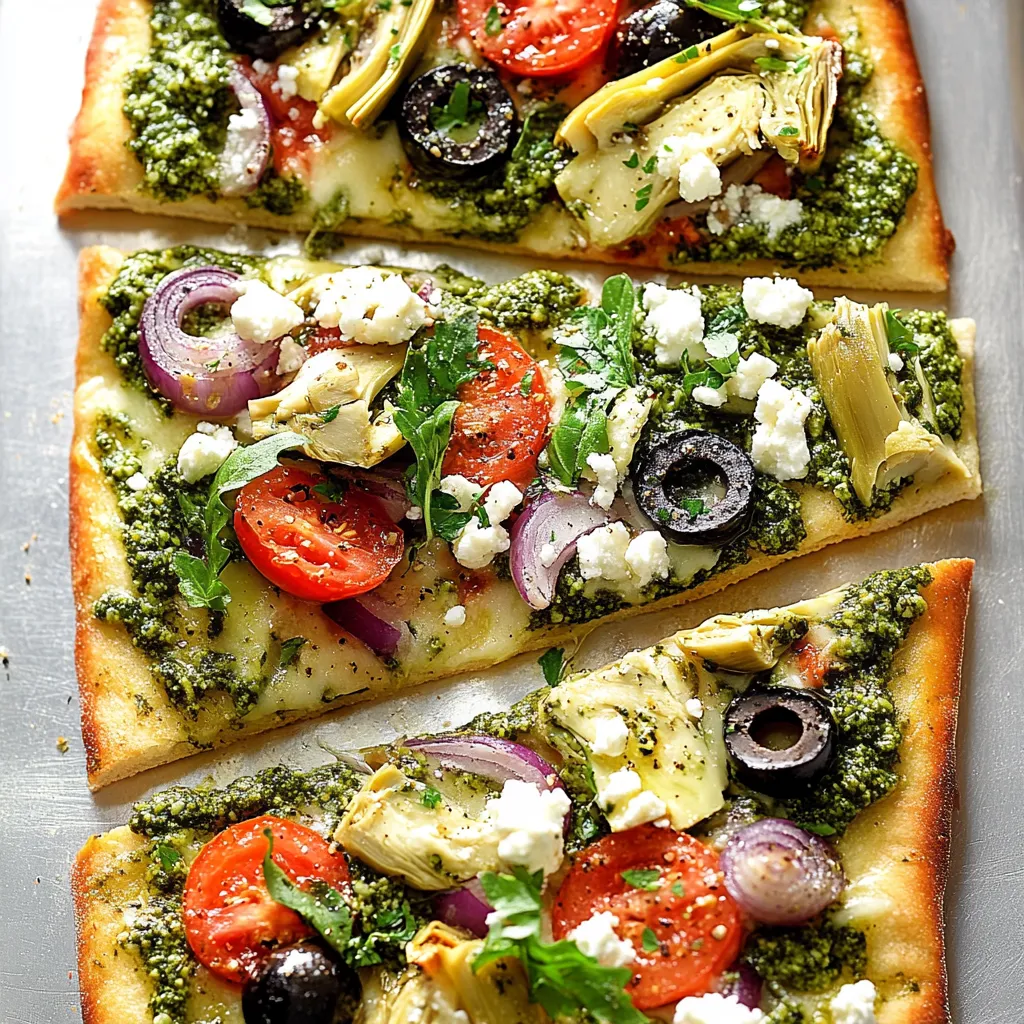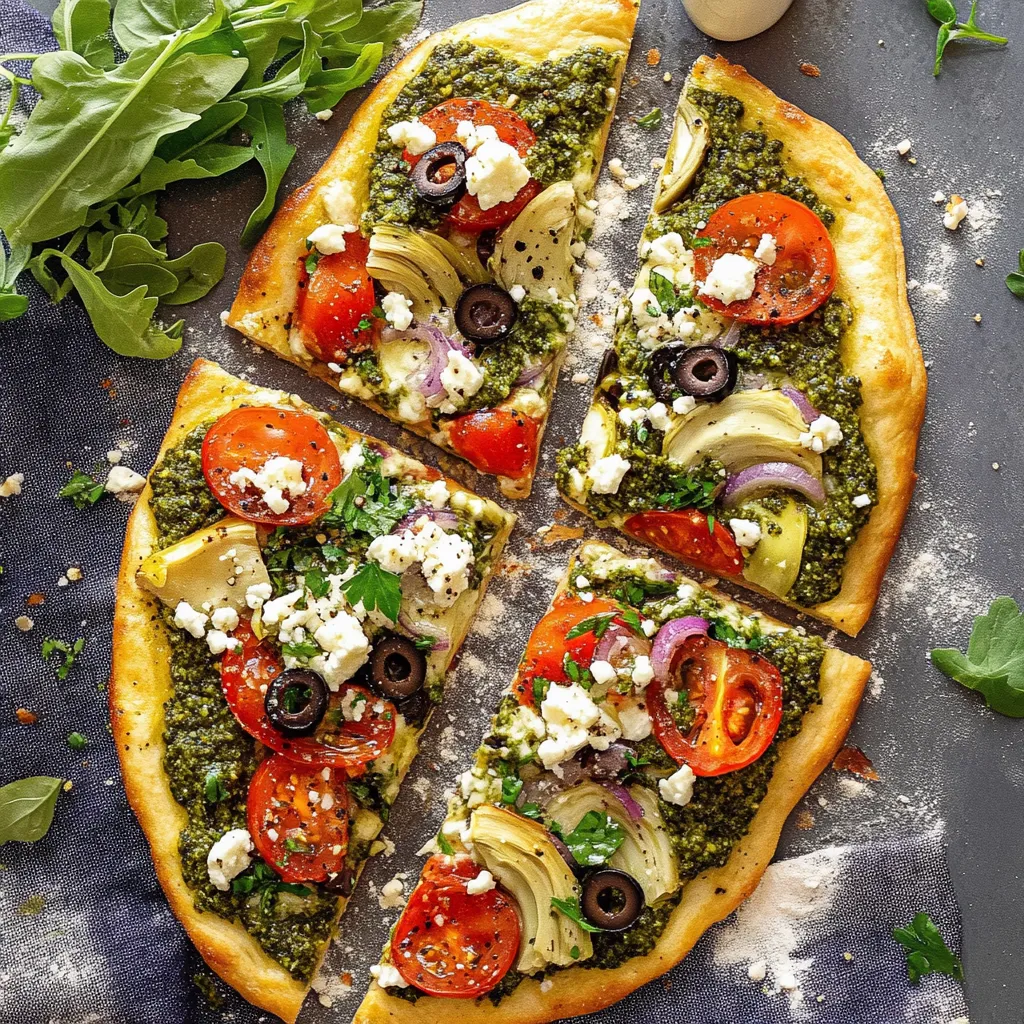 Pin it
Pin it
This vibrant Mediterranean flatbread pizza balances fresh ingredients and bold flavors to create a meal that's simultaneously light yet satisfying. The crispy flatbread base provides the perfect foundation for a colorful medley of toppings—creamy spinach pesto, melty mozzarella, tangy feta, tender artichoke hearts, zesty red onion, juicy grape tomatoes, and briny black olives. It's a delightful way to enjoy the essence of pizza while incorporating an abundance of vegetables.
I made this for an impromptu dinner with friends last Friday, and even my neighbor's teenager who "doesn't eat vegetables" went back for seconds! My husband, who typically orders meat-lovers pizza, didn't miss the pepperoni at all and commented on how the combination of flavors made this more satisfying than our usual takeout.
Ingredients:
- Flatbread crust - The foundation of this dish, providing a crispy, crunchy base that stands up to the fresh toppings. Homemade flatbread delivers the best texture and flavor, but quality store-bought options work well when you're short on time.
- Spinach pesto - Adds a vibrant, herbaceous layer that infuses every bite with fresh flavor. The combination of spinach, basil, garlic, and nuts creates more depth than traditional tomato sauce while complementing the Mediterranean toppings perfectly.
- Mozzarella cheese - Provides that quintessential melty, stretchy texture we all crave from pizza. Its mild flavor allows the vegetables and feta to shine while creating a creamy foundation for the other toppings.
- Feta cheese - Delivers bright, tangy pops of flavor and creamy texture that contrasts beautifully with the mozzarella. Its distinctive briny quality enhances the Mediterranean profile of this flatbread.
- Artichoke hearts - Tender yet firm, with a subtle earthiness that adds both flavor and substantial texture. Their mild taste absorbs the surrounding flavors while adding a distinctive Mediterranean element.
- Red onion - Contributes a sharp, pungent flavor that mellows slightly during baking. The thin slices add color, crunch, and aromatic depth to each bite.
- Grape tomatoes - Burst with sweet-tart juice when roasted, creating pockets of bright flavor throughout the flatbread. Their natural sweetness balances the saltier elements like olives and feta.
- Black olives - Provide distinctive briny notes and meaty texture that make this flatbread unmistakably Mediterranean. Their rich umami quality adds depth and complexity to the overall flavor profile.
- Fresh oregano - Infuses the flatbread with aromatic, herbaceous notes that enhance all the other ingredients. Fresh oregano has a more vibrant flavor than dried, though both work well.
Instructions:
- Prepare your flatbread base by either making homemade flatbread dough or using store-bought. For homemade, combine 2 cups all-purpose flour, 1 teaspoon baking powder, 1/2 teaspoon salt, 2/3 cup water, and 3 tablespoons olive oil in a food processor. Pulse until it forms a ball, then knead on a floured surface for just 1 minute. Divide into two portions and roll each into a thin oval or rectangle about 1/4-inch thick. Par-bake these flatbreads on a preheated baking sheet at 450°F for about 4-5 minutes, just until they begin to firm up but before they brown significantly. This partial cooking ensures your crust will be crispy rather than soggy once topped. If using store-bought flatbreads, you can skip the par-baking step if they're pre-cooked (like naan), but if they're raw dough, follow the same par-baking instructions.
- Create a flavorful base by brushing each par-baked flatbread with a light coating of olive oil, which adds richness and helps prevent the crust from becoming soggy. Then spread about 2 tablespoons of spinach pesto over each flatbread, leaving a small border around the edge for a proper crust. The pesto should be spread thinly and evenly—too much will make the flatbread soggy, while too little won't provide enough flavor. If you don't have spinach pesto, you can substitute traditional basil pesto or simply brush with olive oil and sprinkle with minced garlic for a similar aromatic foundation.
- Layer your cheeses strategically by first sprinkling each flatbread with about 1/2 cup of shredded mozzarella, distributing it evenly but not too heavily. This first layer of cheese creates a barrier between the pesto and the vegetables, which helps prevent the crust from becoming soggy from vegetable moisture. Reserve the crumbled feta (about 1/4 cup per flatbread) for later in the assembly process—adding it on top allows its distinctive flavor to shine and creates attractive pops of white against the colorful vegetables.
- Arrange your vegetables thoughtfully by first adding halved grape tomatoes (about 1/2 cup per flatbread) and thinly sliced red onion (about 2 tablespoons per flatbread), distributing them evenly across the mozzarella. Follow with drained and quartered artichoke hearts (about 1/3 cup per flatbread) and sliced black olives (about 2 tablespoons per flatbread). The key is to create an even distribution of toppings so every bite contains a variety of flavors and textures. Avoid piling vegetables in the center, which can lead to uneven cooking and a soggy middle.
- Finish with flavorful garnishes by sprinkling the reserved crumbled feta cheese over the vegetables, along with a generous pinch of fresh oregano leaves or 1/2 teaspoon dried oregano per flatbread. Add a light sprinkle of kosher salt (about 1/4 teaspoon per flatbread) and a few grinds of black pepper to enhance all the flavors. The salt is particularly important as it helps bring out the natural sweetness in the vegetables and counterbalances the richness of the cheeses.
- Bake to perfect crispness by placing the assembled flatbreads on a preheated baking sheet or pizza stone in a 450°F oven for 7-10 minutes. Watch carefully—you want the edges to become golden brown and crispy, the cheese to melt completely, and the vegetables to soften slightly while still maintaining their texture. The high temperature ensures a crispy crust and helps the vegetables roast rather than steam, intensifying their flavors. If your oven has a convection setting, using it will help achieve an even crispier result.
- Garnish and serve immediately by removing the flatbreads from the oven and finishing with a sprinkle of freshly chopped parsley or a handful of fresh arugula, which will slightly wilt from the residual heat. The fresh herbs add a burst of color and a final layer of flavor. Cut each flatbread into quarters or sixths using a sharp knife or pizza cutter, and serve while still warm to enjoy the contrast between the crispy crust and the melty cheese.
 Pin it
Pin it
I discovered through trial and error that slicing the red onion paper-thin makes a huge difference in this recipe. Too thick, and the onion remains too sharp and doesn't cook through properly. When sliced ultra-thin, it caramelizes slightly during baking, adding sweetness that balances the salty feta and olives perfectly.
Perfect Pesto Selection
While the recipe calls for spinach pesto, don't feel limited if you don't have it on hand. Traditional basil pesto works beautifully, as does sun-dried tomato pesto for a different flavor profile. If making your own spinach pesto, combine 2 cups fresh spinach, 1/2 cup fresh basil, 1/3 cup toasted pine nuts (or walnuts for a more budget-friendly option), 2 garlic cloves, 1/2 cup grated Parmesan, 1/2 teaspoon salt, and 1/3 cup olive oil in a food processor until smooth. The addition of spinach to traditional pesto not only boosts nutrition but creates a milder flavor that complements rather than overwhelms the other Mediterranean ingredients. For a time-saving tip, make a double batch of pesto and freeze portions in ice cube trays—pop out a few cubes whenever you want to make this flatbread.
Strategic Vegetable Preparation
The way you prepare each vegetable affects both the texture and flavor of the finished flatbread. Grape tomatoes should be halved lengthwise rather than crosswise, which allows them to release some moisture during cooking without becoming too juicy. For artichoke hearts, be sure to drain them thoroughly and pat dry with paper towels to remove excess moisture. Quartering them creates perfect bite-sized pieces that distribute easily across the flatbread. When adding black olives, slicing them allows their flavor to disperse more evenly than leaving them whole. For a more complex flavor profile, consider mixing kalamata olives with black olives—the combination provides both depth and brightness. Remember that vegetables continue cooking from residual heat after removing from the oven, so it's better to slightly undercook than overcook them.
Make-Ahead and Storage Options
This Mediterranean flatbread can be partially prepared ahead of time to make weeknight dinners even easier. The flatbread dough can be made up to 24 hours in advance and stored in the refrigerator—just bring it to room temperature before rolling out. Alternatively, par-bake the flatbreads and store them at room temperature for up to 8 hours or refrigerate for up to 2 days. All vegetables can be prepped and stored separately in the refrigerator a day ahead. For leftovers, reheat in a 350°F oven for 5-7 minutes rather than microwave to restore the crispy texture. While not ideal, you can freeze fully baked and cooled flatbread pizza by wrapping individual portions in plastic wrap and then foil—reheat directly from frozen in a 375°F oven for about 10-12 minutes.
I started making this flatbread on Friday evenings as a way to use up vegetables before our weekend farmers' market run. What began as a practical solution has become a cherished tradition—we open a bottle of wine, put on some music, and assemble our flatbreads together. There's something deeply satisfying about transforming simple ingredients into something so vibrant and flavorful. My mother-in-law, who is notoriously picky about restaurant meals, requested the recipe after trying it at our house and now makes it regularly for her bridge club. The combination of a crispy crust, creamy cheese, and Mediterranean vegetables creates something that's so much more than the sum of its parts.
Frequently Asked Questions
- → Can I use store-bought flatbread for this recipe?
- Absolutely! While the homemade 5-minute flatbread is recommended, store-bought options like Stonefire naan work great too.
- → What can I substitute for spinach pesto?
- You can use store-bought pesto or simply brush the crust with olive oil and add thinly sliced garlic for a similar flavor profile.
- → Can I make this recipe ahead of time?
- You can prep all toppings ahead of time, but it's best to assemble and bake just before serving to keep the crust crispy.
- → How do I keep my flatbread from getting soggy?
- Keep to the recommended amounts: about 1/4 cup sauce, 4 ounces cheese, and 1 cup of veggies per flatbread to maintain the perfect balance.
- → Can I use regular pizza dough instead of flatbread?
- Yes! Roll it thin, prick it with a fork, and par-bake for 5-10 minutes at 550°F before adding toppings.
- → Is this recipe suitable for vegetarians?
- Yes, this Greek Flatbread Pizza is completely vegetarian, featuring cheese and vegetables with no meat products.
